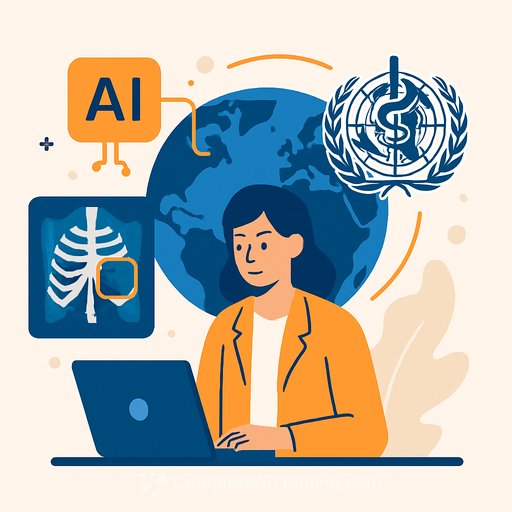How they built a global AI healthcare venture
An H-1B approval to join a US healthcare giant could have closed the book on Qure.ai before it started. Ankit Modi chose a different path based on a single idea: reversibility. If the startup failed, he could still move later. If it worked, the upside was bigger for patients and for the team he believed in.
That bet paid off. Today, Qure.ai's AI-driven imaging and clinical tools are used across 100+ countries, with a strong footprint in the US and deep roots in public health programs worldwide.
The decision that set it in motion
In 2016, Prashant Warier, Preetham Putha, Ankit Modi, and Bhargava Reddy founded Qure.ai to apply deep learning to medical imaging at scale. A chance apartment hunt introduced Ankit to Prashant-fresh off an acquisition-whose operating experience and track record stood out.
"The choice was stark - stay back and build Qure with Prashant, Preetham, and the others, or move to Wisconsin to work in healthcare," Ankit said. Prior startup lessons kept him realistic: the right people, the right technology, and the right timing all have to line up-and even then, nothing is guaranteed.
From idea to clinical validation
Early on, the team hit a major milestone: "One of our first milestones was becoming the first AI company in the world to get published in The Lancet," Ankit noted-recognition that unlocked clinical trust. When Covid-19 surged in Lombardy, Italy, San Raffaele Hospital asked Qure.ai to deploy its chest X-ray algorithm. Months later, Mumbai's municipal corporation did the same, putting the system into high-pressure, real-world use.
WHO guidance and global scale
In 2021, the World Health Organization issued guidance permitting the use of AI-based computer-aided detection (CAD) to interpret chest X-rays without a radiologist present-enabling country programs and donors to procure software alongside imaging hardware. That opened the floodgates for scaled deployment across national TB and screening programs.
Qure.ai's solutions are now live in over a hundred countries. In parallel, AstraZeneca saw that Qure's chest X-ray algorithm could surface early-stage lung cancer candidates for Tagrisso and funded rollouts across hospitals. Merck, Johnson & Johnson, Pfizer, Medtronic, Cipla, and others followed. Tuberculosis and lung cancer solutions account for about 85-90% of the company's revenue.
For TB, the impact is straightforward: places like Lesotho or Malawi have almost no radiologists-Malawi has just two for the entire country-so community screening at volume needs automation. WHO's guidance created a procurement path, and national programs now bundle CAD with X-ray systems.
WHO recommendation on AI for chest X-rays
How the tech matured
The stack evolved from convolutional neural networks in 2016 to deep neural networks and transformer-based architectures. But the secret was domain depth: researchers worked side by side with clinicians until the team functioned like seasoned radiologists.
During validation, performance skewed better on men's X-rays than women's because of biased datasets. The team built a generative solution-pre-ChatGPT-to synthesize data for underrepresented cases and retrained models. They also tuned models for local context, because X-rays from Kenya, Bihar, or Australia have different patterns and artifact profiles. To ground truth and iterate, 75 clinicians travel extensively across sites.
Distribution, products, and pipeline
Qure.ai employs about 280 people across Mumbai, Bengaluru, London, the US, Dubai, and Africa. "Distribution has become the key moat," Ankit said. The company is deeply embedded in primary healthcare centers, where screening volumes and workflow integration matter most.
The team recently launched AIRA, an AI assistant that listens to doctor-patient conversations, suggests better questions, offers differential diagnoses, and auto-fills EMRs. They're also building solutions for COPD and early indicators of heart failure.
Business footing
Qure.ai has raised $120 million and is valued at over $500 million. The company expects to break even by the next financial year. In Ankit's words: "Funding will only be for expansion, not survival."
What this means for healthcare leaders
- Extend radiology capacity: CAD for chest X-rays is now supported by global guidance, enabling high-throughput screening where specialists are scarce. Consider bundling software with imaging procurement.
- Co-create with pharma: Early-detection programs (e.g., lung cancer) can be co-funded when they help surface eligible patients for approved therapies.
- Audit and correct bias: Check model performance by sex and site. Use synthetic data and local tuning to close gaps before scale-up.
- Prioritize workflow fit: Integration in primary care and documentation support (e.g., AI scribes) can drive clinician adoption and measurable throughput gains.
- Upskill teams: Build AI literacy across clinical, operations, and IT to select, deploy, and govern these tools effectively. For structured options by role, see curated AI courses by job.
Your membership also unlocks:






